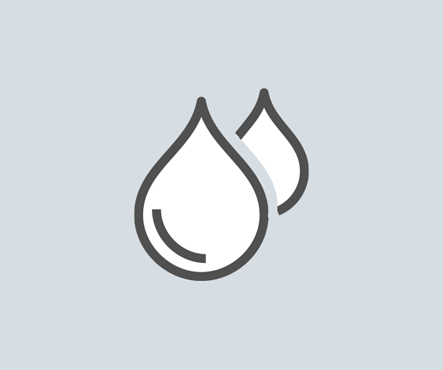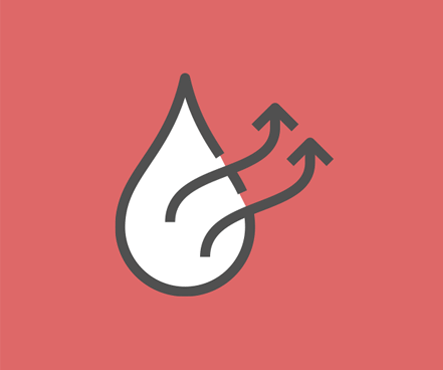Keylite Roof Windows are manufactured to the highest possible standards and are certified by worldwide recognised certification bodies, however water may still condense on the surface of Keylite roof windows, as this is a natural phenomenon.
Measures to help control Condensation
Today, most buildings are highly insulated and in turn, this is greatly reducing natural ventilation which is vital. The installation of draft excluders, carpets and removing open fires and replacing them with central heating are all factors which add to reducing natural ventilation. Due to this, buildings have been effectively sealed which in turn, keeps the moisture created trapped in the building, causing risk of condensation to occur.
The recommended relative humidity level is between 5-8%. This range will provide best comfort levels along with helping to protect wooden products within the building from the damaging effects of excessive moisture or dryness. If there is too much moisture in the air (over 8%), the building needs to be aired out by opening the windows and doors when and where possible for as long as possible.
On dull and damp days, this will be harder to do, but by leaving the vent flap handles on your Keylite Roof Windows open, this will aid natural ventilation. When the vent flap handle is opened, the window is still securely locked.
Please note: This is not a permanent solution in extreme cases or in drying out new builds.
Condensation in modern homes
Condensation was a common occurrence in homes prior to advances in double glazing and central heating, however with the introduction of efficient insulation and compulsory ventilation the problem was largely eliminated.
Ironically, the latest drive to achieve airtightness as a route to energy efficiency in homes may cause issues with condensation once again.
Condensation risk is particularly high in newly built homes where the water used in concrete floors, walls and plaster, will be released into the house during the drying out process which typically lasts 12 – 18 months.
What is Condensation?
- Condensation occurs where moist air comes into contact with air, or a surface, which is at a lower temperature.
- Air contains water vapour in varying quantities, warm air will hold more moisture than cold air.
- When moist air comes into contact with either a colder surface or colder air, it is unable to retain the same amount of moisture so the water is released to form condensation in the air or on a surface.
- Condensation is most noticeable on non-absorbent surfaces e.g. Glass, but it can form on any type of surface and not become apparent until a mould growth appears or until it is too late and the material has already been damaged.
Condensation and roof windows
Due to the position of roof windows, they are more exposed to the elements. This means they are cooled considerably more than vertical windows and due to the fact that warm air rises, condensation will form on the glass of a roof window before a vertical window in the same environment.
In extreme cases of condensation, drips may develop and may incorrectly suggest a leak. This issue can occur if a roof window has been installed without the proper insulation around the roof window’s frame.
When left un-insulated, the gap in the roof allows a cold bridge through the frame, cooling the internal surface to below dew point temperature. This causes condensation to form on the frame which can run off onto surrounding surfaces with the risk of mould growth.
By choosing a Keylite roof window with an expanding thermal collar you can minimise the risk of condensation. To further support this, the BRE 2018 report suggests that the addition of an expanding thermal collar limits the risk of internal surface condensation and mould growth.
Increased condensation may also be the result of excessive moisture release in the home.
Conditions for Condensation
- Condensation is a seasonal problem occurring mainly in winter, however can occur at any time of the year depending on the weather conditions.
- The moisture in the air comes from a number of sources within the home or building.
- On average, it takes a new building a number of months to completely dry out. During this drying period, the moisture of the air can come from a number of different sources within the building.
- New Builds – concrete floors, newly plastered walls, ceilings, rainfall into the building, wetting timber and blocks before the roof is put on.
- Normal Living conditions – cooking, showers and baths, washing and drying clothes.
Four Simple Steps to combat condensations
Now that you are aware of the causes of condensation, you can take these simple steps to reduce condensation in your home.
Remember, the inside of your building can only dry out if the moisture can get out!
It is unlikely that any home can be totally condensation free, but by keeping the property well ventilated and properly maintained, condensation should not cause you too many problems.
Other Guides
Backed by a guarantee
up to 10 years.
20 years on Polar White PVC Centre Pivot Roof Windows
Keylite Roof Windows and Flashings are covered by a 10 year guarantee, with a new 20 year guarantee on Polar White PVC Centre Pivot Roof Windows.
Get In Touch
By Phone
To learn more about caring for your Keylite product, please call our Customer Service Team: 01283 200 158
Call NowBy LiveChat
We are available on LiveChat to answer any queries you may have.
Monday - Friday, 9am-5pm
By Email
We are always available via email to talk about caring for your Keylite products. Simply send an email to us: info@keyliteuk.com
Get In Touch


